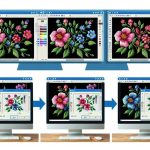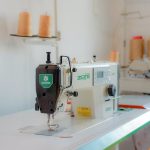Are you interested in organizing a fashion show? Whether it’s for a school project or a professional event, putting together a successful show takes careful planning and execution.
Fortunately, there are resources available to help you along the way, including this guide on how to organize a fashion show in PDF format.
In this guide, you’ll learn the steps to take in order to ensure your fashion show is a hit. From defining your concept and theme to choosing the right venue and selecting your models, each step is essential to creating a cohesive and memorable event.
So if you’re ready to dive in and start planning your fashion show, let’s get started!
Table of Contents
Define Your Concept and Theme
Define your concept and theme.
You’ll need to come up with a clear concept and theme that ties together the different elements of your fashion show, such as the music, lighting, and clothing choices. This will help create a cohesive and memorable event for your audience.
Start by brainstorming ideas and inspiration. Look to current fashion trends, art, music, and cultural events for inspiration. Think about what message you want to convey with your show, whether it’s a particular style or message.
Once you have a clear concept and theme, it’s important to communicate it to your team. Make sure everyone involved in the fashion show is on the same page and understands the vision. This includes designers, models, stylists, DJs, lighting technicians, and anyone else involved.
Provide them with a detailed brief or mood board that outlines the concept, theme, and aesthetic you’re going for. This will ensure that everyone is working towards the same goal and will help to minimize any miscommunications or misunderstandings.
Remember to be flexible and open to change. Your concept and theme may evolve as you work on the show, and that’s okay. Be willing to adapt and make changes as needed to ensure that the final product is the best it can be.
And most importantly, have fun with it! Fashion shows are meant to be creative and exciting, so don’t be afraid to take risks and try new things.
Plan Your Budget
When planning your fashion show, it’s important to consider your budget and the costs associated with the event. You’ll need to determine the cost of the venue, models, and production, and factor these expenses into your budget.
Seeking sponsorships and partnerships can also help offset costs and bring in additional revenue. By being mindful of your budget and seeking opportunities for collaboration, you can create a successful and financially sustainable fashion show.
Determine the Cost of Venue, Models, and Production
To throw a successful fashion show, it’s important to factor in the cost of the venue, models, and production. These three factors can make up a significant portion of your overall budget, so it’s important to determine their costs early on in the planning process.
To help you get started, here are three things to consider when determining the cost of your fashion show:
-
Venue rental fees: Depending on the size and location of the venue, rental fees can vary greatly. Some venues may require a deposit or additional fees for things like security or cleaning services. Be sure to factor in these costs when determining your overall budget.
-
Model fees: If you plan on hiring professional models for your fashion show, you’ll need to pay them for their time and services. Fees can vary depending on the experience and level of the model, so be sure to research and negotiate fees ahead of time.
-
Production costs: This includes everything from lighting and sound equipment to set design and backstage staff. Production costs can add up quickly, so it’s important to have a clear understanding of what you’ll need and how much it will cost.
By factoring in these costs early on, you can ensure that your fashion show is a success without breaking the bank.
Seek Sponsorships and Partnerships
Looking for sponsorships and partnerships can be a great way to cut down on costs and increase exposure for your event. Approach businesses and organizations that align with your fashion show’s theme or target audience. Offer them advertising opportunities and exposure in exchange for their support.
This can include placing their logo on your marketing materials, having them sponsor a specific part of the show, or even providing them with a booth at the event. When seeking sponsorships and partnerships, be sure to have a clear proposal outlining what you’re asking for and what you can offer in return.
Highlight the benefits of partnering with your event, such as the potential for increased brand visibility and positive press coverage. Don’t be afraid to get creative and think outside the box when it comes to potential sponsors and partners. By working together, you can create a successful and memorable fashion show that benefits everyone involved.
Choose the Right Venue
So, you’re ready to choose the right venue for your fashion show.
First off, consider the size and layout of the venue. Will it accommodate the number of attendees and models you’re planning for?
Next, evaluate the lighting and sound system. Are they up to par with the type of show you’re putting on?
Keep these key points in mind to ensure a successful event.
Consider the Size and Layout of the Venue
When choosing a venue for your fashion show, it’s crucial to consider the size and layout of the space. You want to make sure that the venue is large enough to accommodate your audience, models, and any other necessary equipment. Additionally, you want to ensure that the space is appropriately laid out, so that the audience can see the runway and the models can easily navigate the space.
When considering the size of the venue, think about how many people you plan to invite. You’ll want to make sure that there is enough seating for everyone, as well as enough standing room for any additional guests.
You also need to consider the size of the runway and the backstage area. If the runway is too small, it will be difficult for the models to showcase your clothing properly. If the backstage area is too cramped, it will be challenging for the models to change quickly between outfits.
By considering the size and layout of the venue, you can ensure that your fashion show runs smoothly and that your audience and models have an enjoyable experience.
Evaluate the Lighting and Sound System
Make sure the venue’s lighting and sound system create a stunning atmosphere that complements your clothing designs and sets the mood for your audience to be transported into your fashion world. The lighting should be balanced and not too bright or too dim, allowing the audience to see the clothing designs clearly without being blinded or struggling to see. The sound system should also be evaluated to ensure that the music is clear and audible, enhancing the overall experience.
To evaluate the lighting and sound system, you can use the following table as a guide:
| Lighting | Sound |
|---|---|
| Check the color temperature and brightness level | Test the sound quality and volume |
| Consider the placement of the lights and how they will highlight the clothing designs | Choose appropriate music that matches the mood of the show |
| Ensure that the lighting is consistent throughout the venue | Check for any technical difficulties and have a backup plan |
| Hire a professional lighting and sound technician to help with the setup and troubleshooting | Test the lighting and sound system before the show to make sure everything is working properly |
By taking the time to evaluate the lighting and sound system, you can ensure that your fashion show is a success and that the audience is captivated by your clothing designs. A well-designed and well-executed fashion show can leave a lasting impression on your audience and help to establish your brand as a leader in the fashion industry.
Select Your Models
When selecting models for your fashion show, it’s important to consider both the number and diversity of models needed to showcase your collection effectively.
Determine how many models will be necessary to showcase all of your designs and ensure that you have a diverse range of models representing different ages, ethnicities, and body types.
Hosting a casting call is a great way to find the perfect models for your show. This allows you to see a wide range of potential candidates and choose those who best fit your vision and style.
Determine the Number and Diversity of Models
To ensure inclusivity, it’s important to have a diverse range of models for your fashion show. This means considering factors such as race, ethnicity, body shape and size, age, and gender identity. It’s important to remember that your audience is diverse and will appreciate seeing models who represent them.
Additionally, having a diverse range of models can also attract a wider audience and increase the visibility and success of your fashion show.
When determining the number of models, consider the size of your venue, the number of outfits you have to showcase, and the length of your show. You want to make sure that each model has enough time on the runway to showcase the outfit and that the audience has enough time to appreciate it.
It’s also important to consider the comfort and well-being of your models. Don’t overload them with too many outfit changes or make them wait for long periods of time.
By carefully considering the number and diversity of your models, you can create a fashion show that is both inclusive and enjoyable for everyone involved.
Host a Casting Call
Now that you’ve determined the number and diversity of models for your fashion show, it’s time to host a casting call to find the perfect fits for your clothing line. This is where you can showcase your brand and get a feel for how your clothes look on real people.
Remember, it’s important to have a diverse range of models to represent your brand and appeal to a wider audience. Here are some tips to help you host a successful casting call:
- Advertise the casting call on social media and fashion websites to attract a diverse range of models.
- Have a clear set of requirements and criteria for your models, including height, measurements, and experience level.
- Prepare a runway or space for the models to walk and showcase your clothing line.
During the casting call, take note of each model’s runway walk, posture, and overall look. This will help you select the best models to represent your brand.
Don’t be afraid to ask the models questions and get to know them better. Remember, your models will be the face of your brand, so it’s important to find the right fit for your clothing line.
Plan Your Production
First, you need to decide on the overall theme and concept for your fashion show. This will set the tone for the entire event and help guide your production decisions. Consider the latest trends and styles in the fashion industry, as well as your target audience. You want your theme to be cohesive and memorable, so take some time to brainstorm and come up with something unique.
Once you have your theme, it’s time to start planning the production. This includes everything from selecting models and clothing to designing the set and lighting. You’ll need to create a detailed schedule and budget to make sure everything runs smoothly. It’s also important to communicate with your team and vendors to ensure everyone is on the same page.
As you plan your production, don’t forget about the smaller details that can make a big impact. For example, music selection is crucial to creating the right atmosphere. You’ll want to choose songs that fit your theme and keep the audience engaged. You should also consider adding special effects such as fog or confetti to add excitement to the show.
By paying attention to all the details, you can create a fashion show that’s both impressive and unforgettable.
Promote Your Event
One key aspect to ensuring a successful event is promoting it effectively to your target audience, using creative and attention-grabbing methods. A fashion show is no exception. You want people to be excited about attending and talking about it afterwards. To do this, you need to create a buzz around your event. Here are some ways to achieve this:
| Method | Description | Pros |
|---|---|---|
| Social Media | Use platforms like Instagram, Facebook, and Twitter to create hype about your fashion show. Share behind-the-scenes content, teasers, and sneak peeks of the collections. | Cost-effective, easy to use, allows for direct interaction with potential attendees. |
| Influencer Marketing | Collaborate with fashion influencers who have a large following. They can create buzz around your event by promoting it to their followers and attending the show themselves. | Increases reach, adds credibility to your event, creates excitement. |
| Flyers and Posters | Create eye-catching flyers and posters to distribute in relevant locations such as fashion boutiques, art galleries, and coffee shops. This is a great way to target a specific audience. | Tangible, visually appealing, can be used as a keepsake. |
By using a combination of these methods, you can create a comprehensive promotional strategy that will get people talking about your fashion show. Remember to also utilize your personal network, as word-of-mouth is a powerful tool. With effective promotion, you can ensure a successful event and a full house.
Execute Your Fashion Show
To make your fashion show a success, you need to ensure that every aspect of the execution is done smoothly, from setting up the runway to coordinating with models and designers.
The first step is to make sure that you have a detailed timeline and schedule for the day of the show. This should include everything from the time that models need to arrive for hair and makeup to the start time of the actual show. You should also have a plan in place for any potential issues that may arise, such as a model being late or a wardrobe malfunction.
Next, you will need to set up the runway and make sure that everything is in place for the show to run smoothly. This includes arranging seating for guests, setting up lighting and sound equipment, and ensuring that the runway is clean and clear of any obstacles. You should also have a backup plan in case anything goes wrong during the show, such as a technical difficulty or a model tripping on the runway.
It is important to coordinate with models and designers to ensure that everyone is on the same page. This includes communicating any changes to the schedule or runway setup, as well as making sure that models have the appropriate clothing and accessories for their outfits. You should also have a plan in place for any last-minute changes that may need to be made, such as swapping out a model or changing the order of the runway show.
By executing your fashion show with precision and attention to detail, you can ensure that it’s a success and that everyone involved has a great experience.
- The History and Evolution of Chamois Fabric - June 22, 2025
- Chamois Fabric on Wikipedia: What You Need to Know - June 22, 2025
- How to Pronounce Chamois Fabric Correctly - June 22, 2025





